Don’t Eat the Fruit in The Cell Theatre’s ‘Garden of Eden’ (Review)
Major safety concerns mar a visit to the experiential exhibit in Manhattan
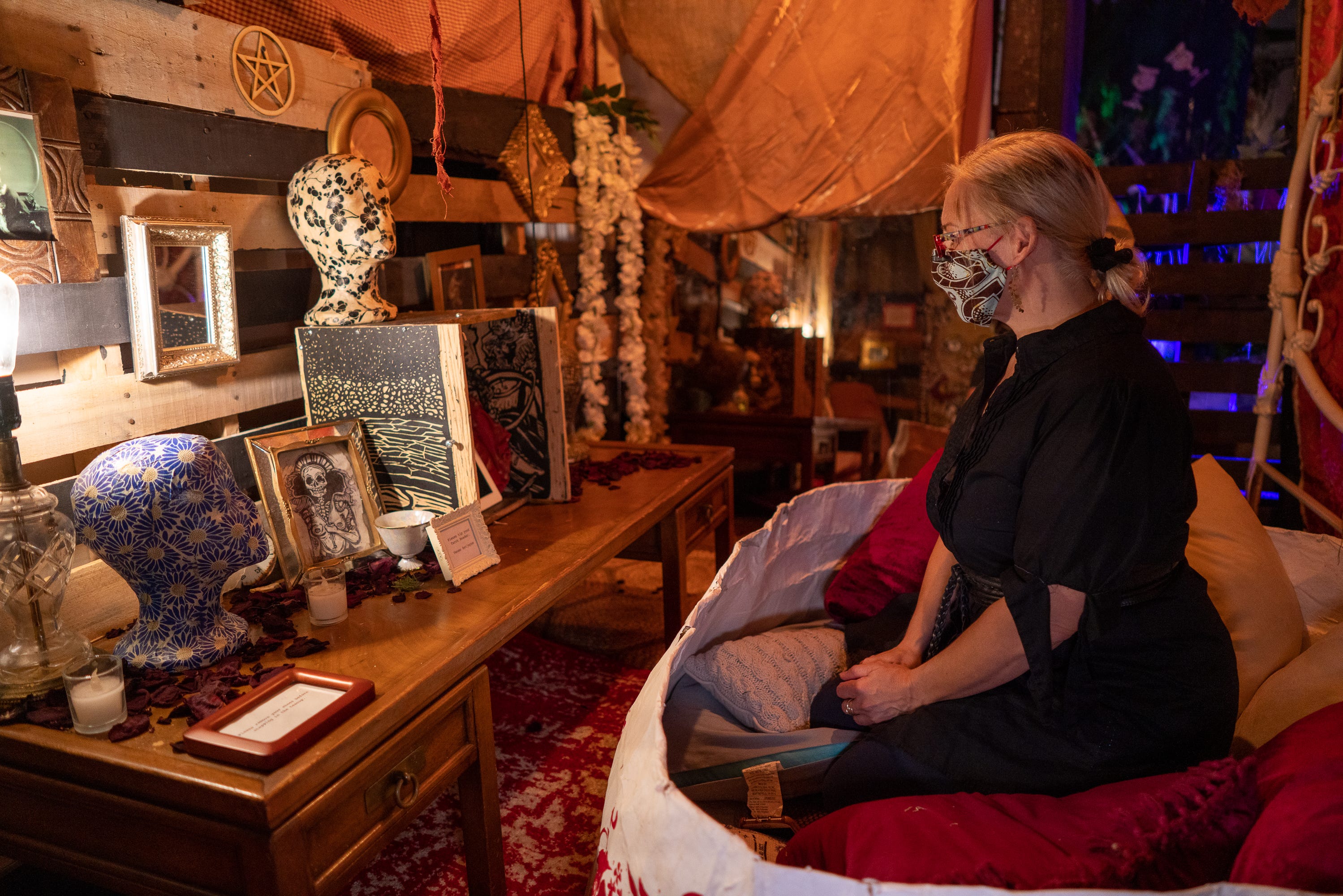

The New York Times called the Garden of Eden, “a sumptuous labyrinth.” The New York Post wrote that the Garden of Eden was “a COVID-safe immersive art experience.” But, to be honest, I am not sure I witnessed the same performance or wandered through the same floor of Nancy Manocherian’s The Cell Theatre in Chelsea.
Before arriving, I found myself excited to step out of my apartment to return to a theater venue for the first time since March this year. And as an immersive creator who was recently certified by the Health Education Services as a COVID-19 Safety Compliance Officer, I was also eager to see how The Cell had managed to re-open its doors.
Unfortunately, the ‘Garden of Eden’ experience seemed to be produced, performed, and showcased in a haphazard manner at a time when care, caution, and safety is of utmost importance.
It was 9:00 pm on a Saturday night when I walked up to the darkly lit Cell Theatre door and turned the handle. It was locked. (I made a note of this as unneeded high touchpoint #1). Bewildered, I looked around to see if I had missed something. After walking back out of the entryway, my plus one and I — both wearing masks — squinted to find an unlit, flimsy paper sign that pointed to the closed door on the opposite end of the building as the entrance to Garden of Eden. I put my hand on that door handle, and it opened gently to reveal a steep set of stairs. We entered the venue.
At the top of the stairs, I found a table decorated with a Garden of Eden sign. Two people stood behind standing on a lawn of turf. We all gave each other a masked hello with a nod, wave, and squinted smiling eyes. The womxn, who I later learned was co-creator Jaclyn Atkinson, greeted us warmly. She tried to explain to me that we would need to sign a COVID-19 waiver, but it was hard to hear her over the sound of a womxn speaking on the floor above us over a blaring audio system. Jaclyn pointed me to a jar of pens and a stack of papers. She had not asked me or my partner to sanitize our hands, which in fact was stated in the onboarding email I received: “Guests will be asked to use hand sanitizer upon entry.” (I made another mental note: disregard for COVID-19 safety guidelines #1). It was not clearly marked that the pens were sanitized on the jar, so Jaclyn verbally reassured us that they were.
I took it upon myself to use the hand sanitizer located on the table before signing the form, but I was surprised that the mandatory COVID-19 waiver was being executed via pen and paper. Most businesses and productions have foregone the use of paper as much as possible and instead have replaced these potential spreaders with QR codes and online forms. (Unneeded high touchpoint #2).
It also concerned me that neither myself nor my partner was having our temperatures checked, as this is a standard operating procedure for fitness and social New York City indoor spaces that have cautiously re-opened. I have personally experienced this onboarding procedure at venues like Equinox, SOHO House, and Industrious these past few summer months. These same spaces also screen their guests with a verbal quiz that includes questions such as: “Have you been traveling? Have you been exposed? Are you experiencing these symptoms?” We were not asked any such questions at The Cell. (Disregard for COVID-19 safety guidelines #2).
Instead, Jaclyn seemed more interested in showing us a spray bottle and a dirty rag, which she would be using to clean the space before our entry, rather than explaining the waiver we were being asked to sign, or screening us for potential exposure to COVID-19, or taking precautions that we could be tracking COVID-19 via outdoor touchpoints into the theater.
Next, Jaclyn explained to us that there were others in the “garden” and that we would need to wait. She went up the stairs and left my guest and myself waiting at the onboarding table. Her companion, a man whose name I did not catch, was engrossed in his cellphone. I asked him if my guest and I should take a seat on a bench nearby. He said it was fine (with no mention if it had been sanitized).
I began to ask him about the add-on experience The Land of Milk & Honey, but he, unfortunately, did not seem to know what I was talking about. The Land of Milk & Honey is a dining experience that is a sibling to the Garden of Eden, unlocked at an additional cost and only on certain days. Prices for Garden of Eden start at $10 per person, while The Land of Milk & Honey costs up to $340 for a party of four. We later found out that this person did not represent the exhibit, was not a staff member of The Cell, and was not a ticketed guest of the experience. This is especially unsettling because the onboarding email told us: “Staff members are undergoing COVID testing every two weeks and have been instructed to self-assess for symptoms.” There was no verbiage about potentially being indoors and in contact with someone who was not following these guidelines. (Disregard for COVID-19 safety guidelines #3).
Then I noticed an opened bottle of wine sitting on a desk a few feet away behind the onboarding table. It was viewable in plain sight, with a wine glass also visible. Someone had been eating and drinking in this space. I interpreted this to mean that masks were not being worn in areas where the public was passing through, an unnecessary escalation of risk. If the goal of The Cell’s published rules is to make guests comfortable, then this blatant “happy hour” torpedoes that goal. And having what appears to be an unscreened guest of the production in the lobby doesn’t help. (Disregard for COVID-19 safety guidelines #4).
I saw multiple red flags and we hadn’t even begun the actual ‘Garden of Eden’ experience.
Jaclyn returned and explained that we would be having a virtual tarot reading at the end of the experience. To signal the start of the reading, we would receive a call from, and I quote, “an old-timey phone.” She also shared with us that physical red frames in the exhibit were for “interaction,” and the black frames were for “informational purposes.” We were tasked to study these frames for the tarot reading that would happen in about forty-five minutes. She also outlined that there was binder clipped, laminated paper available on request if we were struggling to read the frames. Then we were directed to go upstairs without first sanitizing our hands. (Disregard for COVID-19 safety guidelines #5).
For context, I have visited the Cell Theater multiple times in the past. The venue is a converted Chelsea brownstone which consists of a basement, first floor, second-floor mezzanine, third floor, and fourth floor. The Garden of Eden utilized the second-floor mezzanine as an onboarding space and the third floor as the core of its experience. Thus with the general Garden of Eden ticket, the basement, first floor, and fourth floor are never visited. The third floor of the Cell Theater was split equally down the middle into two sections. The left with green and brown color patterns (earth) and the right with red and yellow (fire) color patterns. Jaclyn would later inform me that the original experience was based on the four elements but admitted that the experience lacked in the “water” and “air” elements.
Neither the “earth”-y side nor the “fire”-y side of the Garden of Eden was the a “sumptuous labyrinth” as described by the New York Times, but rather a straightforward guided path through the space. On the “earth” side was a single red frame that prompted the audience to write down a fear, and tack it onto a wall inside of a room containing a large black-lit heart. This part of the activation had clearly marked sanitized pens and tacks to use, but the paper was not clearly marked. The petite shelf housing the papers confused us, so we ended up touching paper that others had already written on. (Unneeded high touchpoint #3). There were also small red flags with prompts written on them with a black marker, but the words were illegible without touching the corner of the flags to extend them wider. (Unneeded high touchpoint #4).
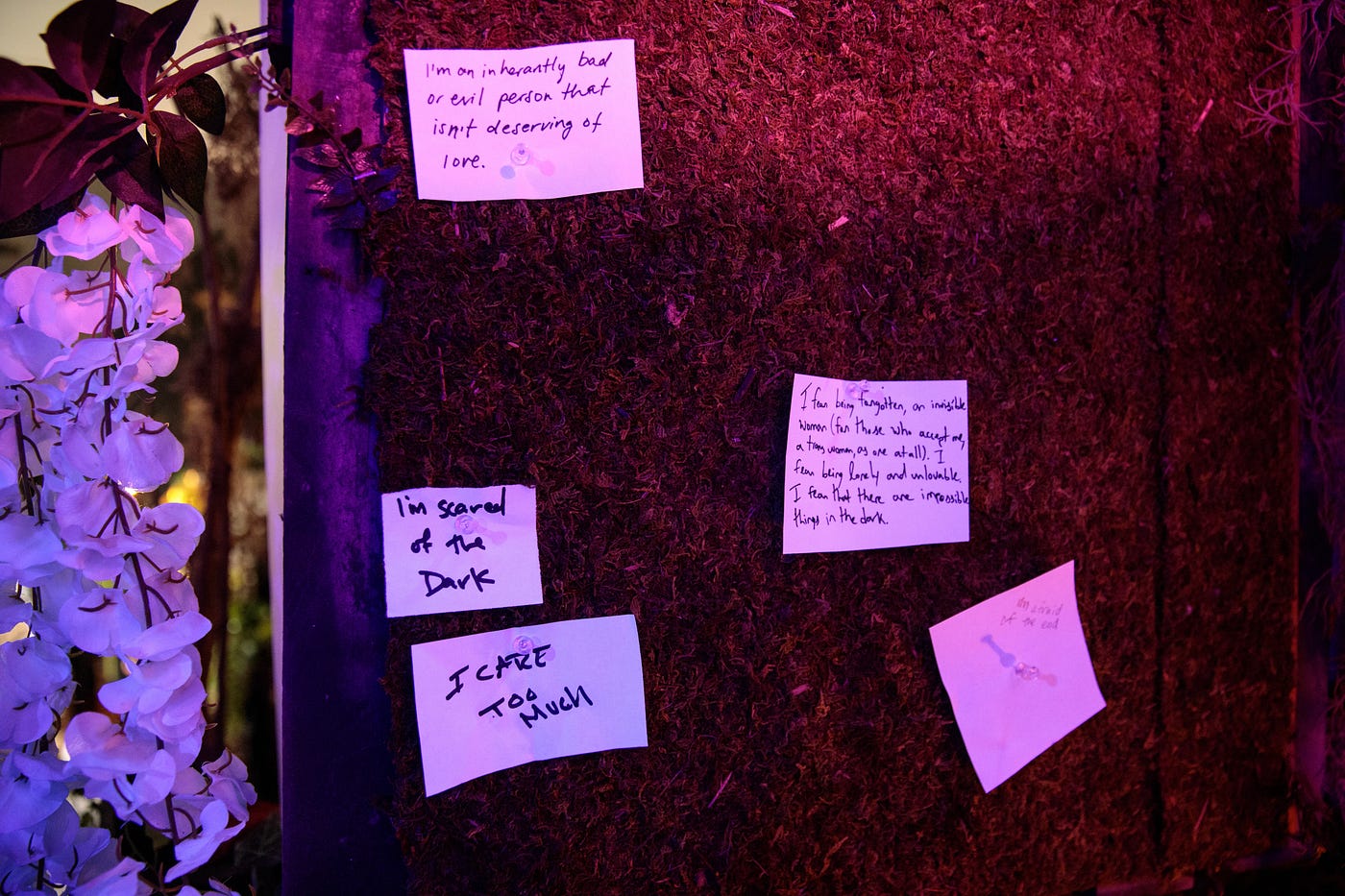
The finale of this side of The Garden of Eden was a large beehive crafted from toilet paper rolls that loomed over a rolling mound of turf. The sound of bees emitted from the JBL speaker to the right of the hive. This, Jaclyn told me after the experience, was the attempt of adding the “wind” element into the space.
The “fire” side of the room had two red frames. The first one prompted the audience to look at themselves in the mirror and speak positive uplifting messages to their reflection. The second one prompted the audience to write down a habit, and add it to the chicken coop wiring inside of the fireplace to symbolize “burning” away the habit. This part of the activation also had clearly marked sanitized pens. But in order to add my paper to the “fire,” I had to navigate my body in a way that I would not touch other people’s rolled papers. (Unneeded high touchpoint #5.)
There was also a water dispenser in this space with cardboard cone-shaped cups stacked on top of each other. My compliance training had drilled into us that any use of a shared water dispenser or buffet style food is highly discouraged, as these can become breeding grounds for any viral spread. Most indoor spaces have turned off drinking fountains for the same reasons. (Disregard for COVID-19 safety guidelines #6). Jaclyn shared that this was the attempt of having the water element within the experience, after a previous incident with water containers that the mice living in The Cell enjoyed nibbling on. I also became concerned that providing shared water and disposable cups within the experience would encourage guests to take their masks off within the indoor space despite the onboarding email that stated: “Guests are required to wear masks at all times.” (Disregard for COVID-19 safety guidelines #7).
Get Michaela Ternasky-Holland’s stories in your inbox
Join Medium for free to get updates from this writer.
SubscribeSubscribe
The finale of this half of the Garden of Eden experience was a large cardboard box shaped like a “teacup” using duct tape. Inside, we found musty pillows. The soundscape playing was a high pitched tone that echoed a suspenseful horror movie. (We would later find out this was the location for the tarot reading.)
This environment and the soundtrack for the experience would prove itself to be problematic for both myself and my guest, which I’ll explain below.
I found Garden of Eden to also have significant accessibility issues. It is best to begin by stating that I have a slight hearing deficiency and that my guest has visual acuity issues. We both align in a belief to make experiences accessible to all abilities. Once upstairs, my partner and I were excited to begin our adventure through the Garden of Eden, but we quickly ran into major roadblocks. The text in the frames was printed at a small font and very difficult to read. My partner went downstairs to request the laminated binder clipped paper. (Unneeded high touchpoint #6).
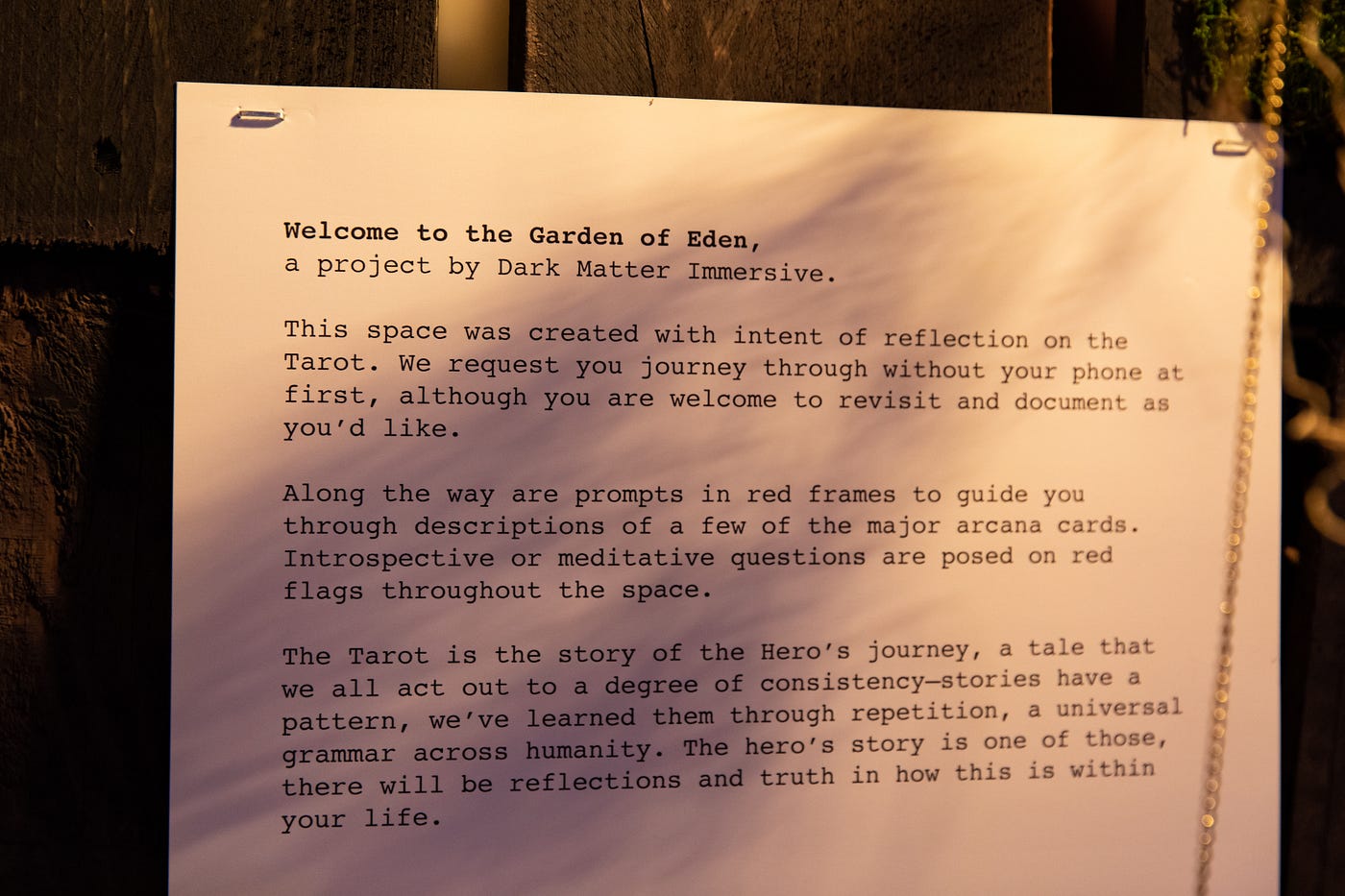
As the interactive red frame prompts can be completed within ten minutes, the bulk of the Garden of Eden experience consists of reading dense paragraphs about tarot cards from the black frames. These tarot cards are painted on cloth at larger than life scale and mounted at many different heights throughout the experience.
But while my partner struggled with reading the wordy-paragraphs on laminated paper, on my end, I struggled to hear him over the buzzing of bees, pounding heartbeats, and suspenseful horror tones.
He and I both felt anxious and agitated throughout the whole process. Reading and learning about the tarot cards themselves had no real consequence or reward. We were not looking for “clues” within the text to unlock the actual tarot reading we were to experience at the end, because Jaclyn already shared with us that that would be automated. The point of the tarot reader is to explain the tarot cards as she is reading them, so the whole reading endeavor felt less interactive and more strenuous than needed because of the poor lighting and imbalanced sound design. (I spoke to Jaclyn about crafting audio versions of these tarot explanations, so that text could become more accessible. She said they would love to explore this for a later iteration, but that they had already maxed out their creative and production bandwidth.)
And, now, back to the “teacup” and our reading. When “the old-time-y phone” did ring, we found that the source was a FaceTime call on an iPad nestled within a wooden milk crate. However, I had to swipe on the iPad to answer the call. (Unneeded high touchpoint #7). Our tarot reader smiling at us from the iPad portal emphatically asked us to sit inside of the “teacup” filled with musty pillows and one small stool. The stool was not large enough for two people, so I had no choice but to sit in the pillows on the floor, while my partner sat on the stool. (Unneeded high touchpoint #8.) I felt very uncomfortable, as there was no specification that someone had actually sanitized these pillows from the last group of guests.
As our tarot reader said hello, it was very hard for me to hear her over the volume of the speakers in the “teacup.” We had to ask Jaclyn to turn it down so I could understand our tarot reader. Once that sound level had been lowered, I felt that I could actually relax for the first time since entering the Garden of Eden. I also began to notice the layers in the audio design. (Jaclyn shared with me that neither she nor Ereka have a background in sound or lighting and that their access to the resident Cell technician had been very limited.)
Our tarot reader was polite and lovely. Unfortunately, due to the vertical orientation of the iPad inside of the crate, she had a hard time seeing both me and my guest at the same time. She also struggled with showing us all three of our past, present, and future cards at the same time as well. The crate was also draped in fabric which kept falling onto our iPad’s front-facing camera lens, and we had to move it in order to see our tarot reader. (Unneeded high touchpoint #9).
At the conclusion of tarot reading, we made our way back down the stairs to the mezzanine of the Cell Theatre and the previously mentioned onboarding area. We were the final guests of the evening, so I took a few moments to briefly interview Jaclyn. Again, we were not directed to sanitize our hands, so after a few minutes ticked by, I reached for the sanitizer on the table and disinfected my palm and fingers. My partner followed suit. (Disregard for COVID-19 safety guidelines #8). At the conclusion of the discussion, my partner and I made our way down the steep stairs and out the door we had entered through. I couldn’t help but wonder the last time that staircase rail or the door handle had been sanitized, as there was no clear indication that either had been. Standing on the dimly lit street, I pulled out my pocket sanitizer spray and gave my hands and my partners a quick spritz before walking away.
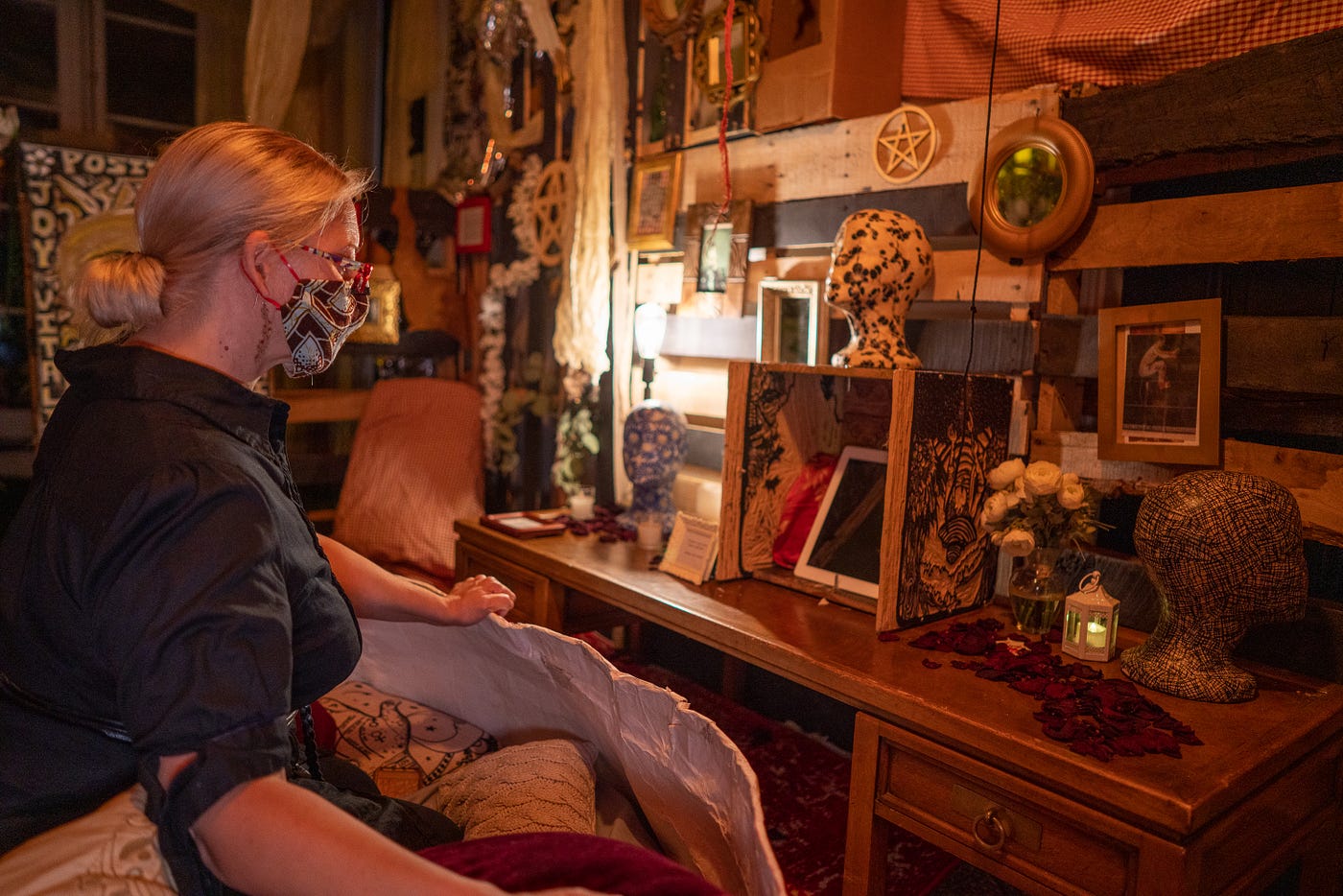
Jaclyn and her co-creator Ereka Duncan are the nucleus of Dark Matter Immersive and create work mainly based in Brooklyn. Jaclyn disclosed to me that Dark Matter Immersive’s usual line up of help and assistance was hard to come by, as most people were hesitant to travel into Manhattan from Brooklyn for the two-week install of the exhibit. The Garden of Eden installation itself is made from shipping pallets, black markered cardboard, and props from previous exhibits. (I also spotted a doll’s head sitting on the vials of lab equipment, as a strong callback to The Cell’s last Halloween season.) When speaking to Jaclyn it seems that the original Garden of Eden concept had been greatly upended due to the pandemic, which is understandable.
Jaclyn also explicitly shared with me that Ereka identifies as Black but that she was away for the weekend working as an art director for a film shoot. My interaction with everyone in the experience, including our tarot reader was all White-appearing. What surprised me was that the tarot cards themselves portrayed every human as White-appearing as well. The only inclusive sign I can recall within the experience was the “dark” sphinx featured in a servitude position as she pulls the White-appearing goddess in The Chariot card. I have read in the New York Times article that Jaclyn and Ereka were inspired by New Orleans folklore. I am not sure where that resonated within the Garden of Eden. Within the Garden, I did not see or explore topics specific to voodoo or Creole/Cajun mythology/spirituality.
Unfortunately, the title Garden of Eden seems to have no correlation with the actual experience. What was actually landed upon was a hyper-focused spotlight on tarot cards, a virtual tarot reading, and lukewarm self-reflective prompts.
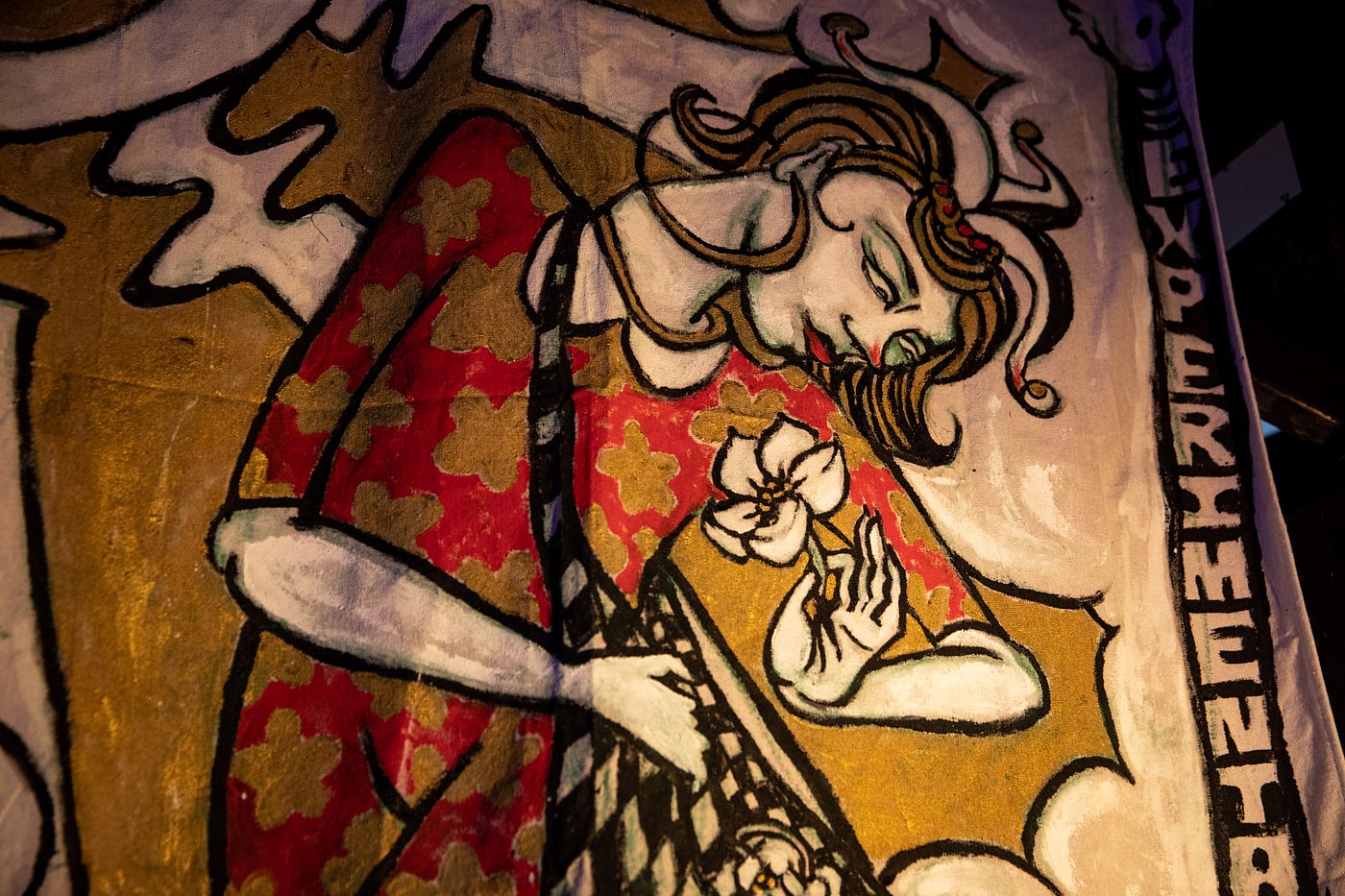
It has been announced that Garden of Eden will extend its run through the Halloween season. It is hard not to compare the production quality to Mikel Glass’ Found. The Cell Theater’s Halloween experience from last year, which utilized all four floors of the Chelsea brownstone. FOUND’s third-floor experience was based on the concept that junk could be transformed into fine art and came complete with cardboard pizza-stained artwork. By comparison, Garden of Eden’s third-floor experience of exposed staples and use of tulle stands at the level of a student project strapped for budget and limited to novice sound and lighting design.
So: in light of the ongoing COVID-19 pandemic, I would say: do not eat of this fruit. (And for public health’s sake, wear a mask, wash your hands, and continue to physically distance.)
Garden of Eden continues through December 19. Tickets are $10–70; The Land of Milk & Honey in conjunction with Garden of Eden is $190–340.
NoPro is a labor of love made possible by our generous Patreon backers. Join them today!
In addition to the No Proscenium web site, our podcast, and our newsletters, you can find NoPro on Twitter, Facebook, YouTube, Instagram, in the Facebook community Everything Immersive, and on our Slack forum.
Office facilities provided by Thymele Arts, in Los Angeles, CA.